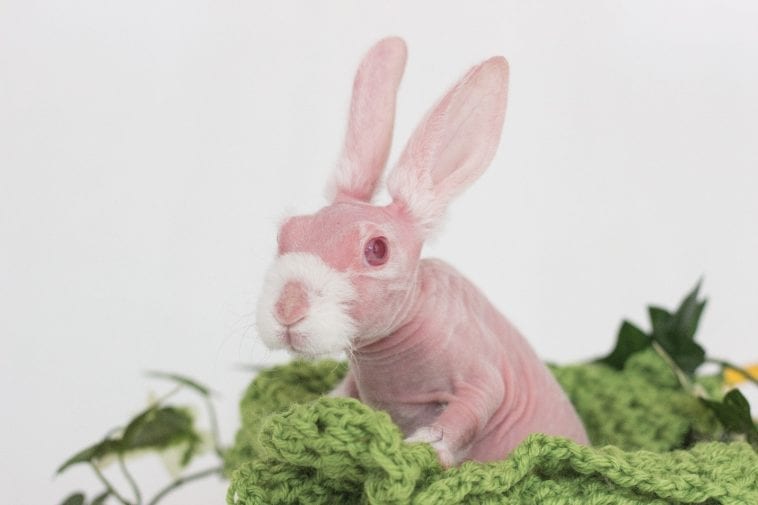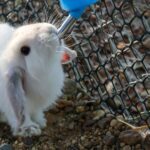Caring for rabbits is one of the most amazing experiences for any pet lover. They are cute, affectionate, and playful animals.
Rabbits are also small, which makes them easier to handle. However, you must remember that they can also be quite delicate in size.
When a rabbit is born, they have specific characteristics that distinguish them. This is also why many people opt to own or adopt a rabbit.
This animal can come in different sizes, breeds, and colors. According to the National Library of Medicine, rabbits’ characteristics help them survive in the wild. For example, their hair serves as protection from cold or heat. With this in mind, have you ever thought if hairless rabbits existed? One popular animal with this kind of character is the sphynx cat.
Hairless Rabbits
Hairless rabbits are just the same as normal rabbits but with lesser hairs. They are bald and have a distinct physical characteristic: pink skin. Because of the lack of hair, they are prone to common diseases like snuffles.
The leading cause of hairlessness in rabbits is because of the recessive gene. Some studies claim that a rabbit must complete the gene development inside its mother’s womb. If a single trait is missing, it causes problems when they are born; hence hairlessness will likely occur.
Moreover, the study added that rabbits born with hairless conditions have a slight chance of living. Since their skin is exposed to the air, they are also prone to diseases. A hairless rabbit needs critical care from someone knowledgeable enough to help the rabbit live.
The first weeks are the hardest because you must keep them warm and away from diseases. But once they survive four weeks of age, this is where they can live naturally like ordinary rabbits.
Example of a Hairless Rabbit
You have probably heard about Mr. Bigglesworth. If not, he is one of the most famous rabbits on the internet today. Not because he is a cute and normal-looking rabbit but because of his condition.
Mr. Bigglesworth is adopted because no one knows if he will live longer. But people are impressed with how he is living right now. He is famous for his cuteness and different outfit to keep himself warm.
Unlike other rabbits, Mr. Bigglesworth does not have hair on his body, but it does not hinder him from living the everyday life he deserves.
Caring for Hairless Rabbits
Extra care is needed for hairless rabbits. But like normal pets, they also have basic requirements. Here are some of the care tips to help you handle hairless rabbits:
Give a good amount of hays
Hay is one of the vital foods for rabbits. Even if they have a hairless condition, their diet is still the same as others. They also have a sensitive digestive system, so they must consume enough fiber to help them metabolize efficiently. Remember to give them water as well, every meal.
Keep them warm
Hairless rabbits get easily cold because they don’t have fur to protect their skin. With this in mind, ensure that you provide them with warm bedding. You can also put on a towel or improvise a cloth to be worn by your pet.
Hair Loss in Rabbits
Hairlessness is a different condition in hair loss. Hairlessness is a condition that is innate to rabbits once they are born. But there is also a condition where an adult rabbit will begin to lose their hair, called alopecia. The Pets Dispensary for Sick Animals (P.D.S.A.) stated that hair loss in rabbits is natural because they shed a lot.
But excessive loss is a health condition. PDSA also added that it is often treatable, especially if you bring your pet as soon as possible you notice they have begun to lose hair.
Alopecia is easy to determine. You just need to look at your pet’s fur and skin condition. When you groom them and notice that a considerable amount of hair is coming with the comb and they have bald patches, this is a clinical sign of alopecia.
Here is the common reason why alopecia occurs in rabbits:
- Stressful situation
- Dirty Environment
- Parasitic Infestation
- Poor skin condition
- Fleas and mites infestation
- Pregnancy
- Tumor
Key Takeaways
- Rabbits are characterized by their size, breed, and fur color. Many people love to have rabbits because of the options that they offer.
- The hairless condition can occur in rabbits. It is a birth trait because of a recessive gene problem.
- When rabbits are born with a hairless condition, you must ensure they are always warm. The first week is the hardest because they are vulnerable to skin exposure.
- Hairlessness is different from hair loss conditions. Hairlessness is innate to rabbits when they are born. But hair loss can result from various problems like stress, a dirty environment, parasitic infestation, mites, fleas, and tumors.
- Extra care is needed for hairless rabbits. Ensure you provide them with a good amount of hays for fiber content. And keep them warm always to avoid snuffles and cold.


